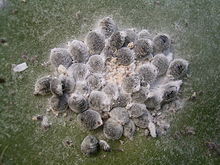
Back کارمینیک اسید AZB Karminsäure German Ácido carmínico Spanish Azido karminiko Basque کارمینیک اسید Persian Karmiinihappo Finnish Acide carminique French Aigéad cairmíneach Irish Ácido carmínico Galician कार्मिनिक अम्ल Hindi
![Chemical structure of carminic acid[citation needed]](http://upload.wikimedia.org/wikipedia/commons/thumb/d/d4/Carminic_acid_structure.svg/230px-Carminic_acid_structure.svg.png) | |
![Ball-and-stick model of carminic acid[citation needed]](http://upload.wikimedia.org/wikipedia/commons/thumb/0/0c/Carminic-acid-3D-balls.png/240px-Carminic-acid-3D-balls.png) | |
| Names | |
|---|---|
| IUPAC name
7-(β-D-Glucopyranosyl)-3,5,6,8-tetrahydroxy-1-methyl-9,10-dioxo-9,10-dihydroanthracene-2-carboxylic acid
| |
| Systematic IUPAC name
3,5,6,8-Tetrahydroxy-1-methyl-9,10-dioxo-7-[(2S,3R,4R,5S,6R)-3,4,5-trihydroxy-6-(hydroxymethyl)oxan-2-yl]-9,10-dihydroanthracene-2-carboxylic acid | |
| Other names
Carminic acid
C.I. Natural Red 4 C.I. 75470 CI 75470 | |
| Identifiers | |
3D model (JSmol)
|
|
| ChEBI | |
| ChEMBL | |
| ChemSpider | |
| ECHA InfoCard | 100.013.658 |
| EC Number |
|
| E number | E120 (colours) |
| KEGG | |
PubChem CID
|
|
| UNII | |
CompTox Dashboard (EPA)
|
|
| |
| |
| Properties | |
| C22H20O13 | |
| Molar mass | 492.38 g/mol |
| Melting point | 120 °C (248 °F; 393 K) (decomposes) |
| Acidity (pKa) | 3.39, 5.78, 8.35, 10.27, 11.51[2] |
Except where otherwise noted, data are given for materials in their standard state (at 25 °C [77 °F], 100 kPa).
| |
Carminic acid (C22H20O13) is a red glucosidal hydroxyanthrapurin that occurs naturally in some scale insects, such as the cochineal, Armenian cochineal, and Polish cochineal. The insects produce the acid as a deterrent to predators.[3] An aluminum salt of carminic acid is the coloring agent in carmine, a pigment.[4] Natives of Peru had been producing cochineal dyes for textiles since at least 700 CE.[4] Synonyms are C.I. 75470 and C.I. Natural Red 4.[5]
The chemical structure of carminic acid consists of a core anthraquinone structure linked to a glucose sugar unit. Carminic acid was first synthesized in the laboratory by organic chemists in 1991.[6][7] In 2018, researchers genetically engineered the microbe Aspergillus nidulans to produce carminic acid.[8]
It was previously thought that it contains α-D-glucopyranosyl residue, which was later redetermined to be the β-D-glucopyranosyl anomer.[9]

- ^ "Carminic Acid". The Merck Index. Royal Society of Chemistry. 2013.
- ^ Atabey, Hasan; Sari, Hayati; Al-Obaidi, Faisal N. (28 April 2012). "Protonation Equilibria of Carminic Acid and Stability Constants of Its Complexes with Some Divalent Metal Ions in Aqueous Solution". Journal of Solution Chemistry. 41 (5): 793–803. doi:10.1007/s10953-012-9830-7. S2CID 95406643.
- ^ Eisner, T.; Nowicki, S.; Goetz, M.; Meinwald, J. (1980). "Red Cochineal Dye (Carminic Acid): Its Role in Nature". Science. 208 (4447): 1039–1042. Bibcode:1980Sci...208.1039E. doi:10.1126/science.208.4447.1039. ISSN 0036-8075. PMID 17779027. S2CID 40209712.
- ^ a b Jan Wouters, Noemi Rosario-Chirinos (1992). "Dye Analysis of Pre-Columbian Peruvian Textiles with High-Performance Liquid Chromatography and Diode-Array Detection". Journal of the American Institute for Conservation. 31 (2). The American Institute for Conservation of Historic &: 237–255. doi:10.2307/3179495. JSTOR 3179495.
- ^ "Approved additives and E numbers". Food Standards Agency. Retrieved 2021-03-12.
- ^ Allevi, P.; et al. (1991). "The First Total Synthesis of Carminic Acid". Journal of the Chemical Society, Chemical Communications. 18 (18): 1319–1320. doi:10.1039/C39910001319.
- ^ Ishida, T.; Inoue, M.; Baba, K.; Kozawa, M.; Inoue, K.; Inouye, H. (1987). "Absolute configuration and structure of carminic acid existing as the potassium salt in Dactylopius cacti L". Acta Crystallographica Section C Crystal Structure Communications. 43 (8): 1541–1544. Bibcode:1987AcCrC..43.1541I. doi:10.1107/S0108270187091169.
- ^ Miller, Brittney J. (25 March 2022). "Cochineal, a red dye from bugs, moves to the lab". Knowable Magazine. doi:10.1146/knowable-032522-1. Retrieved 28 March 2022.
- ^ Fiecchi, Alberto; Galli, Mario Anastasia Giovanni; Gariboldi, Pierluigi (1981-03-01). "Assignment of the β configuration to the C-glycosyl bond in carminic acid". The Journal of Organic Chemistry. 46 (7): 1511. doi:10.1021/jo00320a061. ISSN 0022-3263.